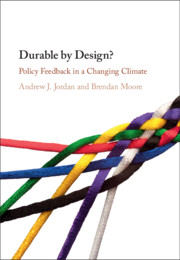Book contents
- Durable by Design?
- Durable by Design?
- Copyright page
- Abstract
- Contents
- Figures
- Tables
- Preface
- Abbreviations
- Part I Policy Durability
- Part II Designing Policy Durability
- 3 Designing Climate Policy in the European Union
- 4 Climate Policy Designs
- 5 Regulation
- 6 Emissions Trading
- 7 Voluntary Action
- Part III Climate Policy
- References
- Index
5 - Regulation
The Governance of Biofuels
from Part II - Designing Policy Durability
Published online by Cambridge University Press: 24 September 2020
- Durable by Design?
- Durable by Design?
- Copyright page
- Abstract
- Contents
- Figures
- Tables
- Preface
- Abbreviations
- Part I Policy Durability
- Part II Designing Policy Durability
- 3 Designing Climate Policy in the European Union
- 4 Climate Policy Designs
- 5 Regulation
- 6 Emissions Trading
- 7 Voluntary Action
- Part III Climate Policy
- References
- Index
Summary
The use of biofuel as a type of renewable energy dates back to the dawn of the global car industry in the nineteenth century. The attractiveness of biofuels derives from their ability to function as a drop-in alternative to fossils fuels such as petrol and diesel. According to the International Energy Agency, if the world is to stay within 2 °C of warming, annual production of transport biofuels must treble between 2017 and 2030 (Raval, 2018). The promotion of renewable energy has been actively discussed in the EU for many decades. But in the late 1990s, a period when EU climate and energy policies were evolving rapidly (see Chapter 3), the EU did not have a coherent, Europe-wide policy to promote the use of biofuels. So, the Commission began to prepare the ground, formulating fresh proposals for an EU-level policy to ramp up domestic production and use. The transport sector was an obvious target, the assumption being that from a technological perspective, greater biofuel use would not be overly disruptive.
- Type
- Chapter
- Information
- Durable by Design?Policy Feedback in a Changing Climate, pp. 106 - 132Publisher: Cambridge University PressPrint publication year: 2020



